6. Sport and Social Inequalities: Demographic Groups
Modern sports, despite their characteristic problems (violence, doping) offer a variety of opportunities that were not present in the traditional sports of the pre-industrial system. It is to be noted, however, although modern sports in theory offer these possibilities, underprivileged social groups do not have a chance, or only have much worse chances, in accessing them (apart from some exceptional, special cases). People living in the countryside, women, and especially people with lower qualifications tend to be less active than townspeople, men and those with a higher qualification (Wilcox et al. 2000).
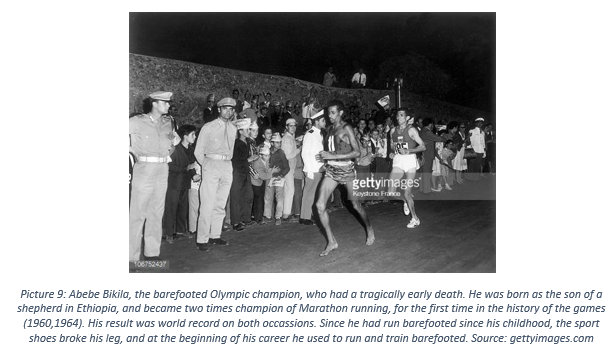
6.1. Elderly Citizens
Over the past decades, the proportion of elderly people has been dynamically increasing in society. The extending elderly age necessitates examinations and prevention programmes that enable elderly citizens to live a healthly, active, cheerful elderly life in their old years. A number of research programmes verify that physical activity is not only indispensable for preventive measures and for health preservation for young people. It is also important for middle-aged people in preserving their health, slowing down ageing, improving their physique, thus increasing their life expectancy.
Johanna Quass, the oldest active athlete in the world illustrates why doing sports actively is important and possible at an old age.
JOHANNA QUAAS (90 YEARS OLD) GUINNESS RECORD KEEPING ATHLETE (video)
6.2. Women
Various research projects have demonstrated the differences between the genders in terms of sport (the number of women doing sports is considerably lower than those of the men) (Keresztes, Pikó 2006; Mota, Silva 1999; Sallis et al. 1996; Sallis et al. 2000). Differences in socialization are supposed to be in the background of the differences between the genders. It is particularly tangible in the case of girls living in the countryside. They find it important to be physically active so as to preserve their figure and feminine features, and they often do not even regard that as a sport (since sport is something that men do). It shows that, in the traditional approach, doing sports is a basically masculine activity, reserved for men, and women only enter there in a much lower number. The lower representation of women in sport is illustrated by various statistics as well (Lee, Macdonald 2008). But the different motivation of women also plays a role in the different statistics; women do sports primarily to remain healthy and pretty, whereas for boys, men competitiveness, triumph, the demonstratrion of their physical strength are important (Keresztes, Pikó 2006). These factors are closely and organically linked to the traditional gender roles.
Jennifer Hargreaves (1994), after a historical and sociological survey of female sportspeople, came to the conclusion that sport still has extremely masculine dimensions, in which power games and the traditional inequalities of the genders have been rooted for hundreds of years. There are, however, critics of these works who claim that the authors are ideologically biased and they lack the due objectivity. All this is important because despite the successes of women in sports, and their expanding possibilities, sport is still a masculine territory, where masculine characteristics and merits (strength, agressivity, competitive and fighting spirit) still prevail (Dunnig 2002). Such masculine values are, for many people, incompatible with the traditional feminine roles and characteristics (for instance, sensitivity, caring for the family, creating and maintaining the family hearth as primary objectives).
The biological differences between the genders are perhaps the most conspicuous in the world of sports, since in sport, especially in competitive sport, physical strength and fitness are indispensable for success. At the same time, we see that in the creation of social genders, and in sustaining the differences between the genders, such social factors as traditional gender roles, socialization and media also play an important role. Perhaps these factors are the most important of them all. Sportswomen find themselves in some sort of a conflict of roles, since competitive sport requires agressivity and competitive spirit, and they need to choose between their feminine identity and their sporting self. They either assume masculine features or some sports and some sportswomen become marginalized. There are also fully feminized sports, such as the case of the cheerleaders. Cheerleading requires a serious physical effort, but chearleaders are often not regarded as real sportswomen. There are social stereotypes about female sports that deterr women fro regular physical excersise, especially competitive sports. Such are that sports are dangerous to childbearing, make the appearance of women masculine, a sporty woman has a lower ”economic” and human value, and sport should not be important for women as it upholds values (agressivity, performance-orientatedness, competitive spirit) that are irrelevant for women. These stereotypes often stigmatize sportswomen and cause role conflicts for them, and at the same time deter other women from sports (Frey, Eitzen 1991).
The pictures below show some historic moments from the 2016 Olympic games of Rio de Janeiro. The pictures show women who were fully able to resists the stereotypes about women and sporstwomen
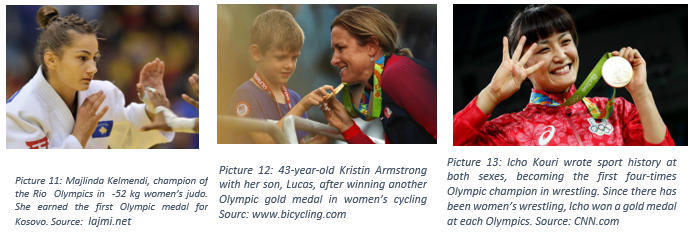
There are research projects that concentrate on sports events relayed and influenced by media, with special attention to how prominent sportswomen appear in the media, and how these representations influence the leisure-time activities of women. Andrea Gál examined the representation of male and female sportspeople in three daily papers: Népszabadság, Magyar Nemzet and Blikk. The researcher wished to find out to what extent external appearance determine the image appearing of a sporstwoman in printed press. It is now referred to as ”Kournikova-syndrome”2.It means that a media regards a sporstwoman more successful, and gives the person more opportunities to appear, when the sportswoman emphasizes her feminine features, has a long hair and wears pretty clothes during doing sport and outside sport as well. Gál found that sporstwomen are underrepresented in printed media as compared to sporstmen. It applies to the period of the Olympic games, although during that time the number of articles and pictures about sporstwomen is higher. As far as the size of the photos, the proportions are somewhat better. It is interesting that sportswomen have a usually more positive image of their own appearance in sports media than the reality (Dr. Gáldiné Gál 2007; Gál et al. 2008).
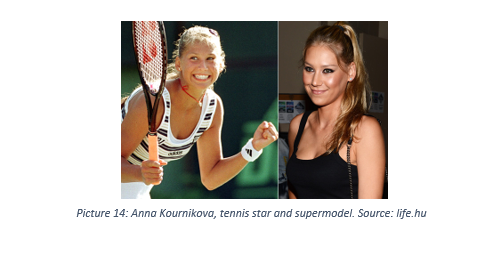
6.3. Racial, Ethnic and Religious Minorities
Legal discrimination was ablished in most of the countries in the 20th century, thanks to the efforts of supranational, international civil rights organizations and their cooperation with the national governments. Social changes, however, do not immediately follow the legal regulation. Prejudice, stereotype continue to exist against various racial, religious, ethnic etc. minorities, and these prejudices sometimes emerge in sport as a social sub-system as well. The members of these minorities are sometimes exposed to verbal or even physical atrocities. In this case we may talk about a latent institutionalization of racism. The explanation efforts of xenophoby include scape-goat formation, frustration, and the projection of anger onto others, specifically on some minority group, including minority sportspeople. There are still various atrocities against sportspeople from the supporters in the audience (cf. Chapter 10.2). FIFA and other umbrella organizations have been fighting these phenomena, launching media campaigns and issuing fines etc. (Bodnár 2015).
SAD MOMENTS OF THE APPEARANCE OF RACISM IN SPORT (videó)
The appearance of racism and prejudices in various sports begins at the participation of various races in various sports. In some sports, the members of some races are overrepresented (e. g. the African-Americans, subject to most of the research projects, are abundantly represented in basketball and American football, and barely present in other sports. The researchers of the topic point out that not only biological differences, but also social stereotypes play a role in these phenomena; for instance, African-American sportsmen may excell in sports that require physical strength, so their participation in sports that require mental effors and a sense of tactics is limited. Another form of hidden discrimination is based upon biological differences and stereotypes, as found by Bower (1972, quoted by Földesiné et al. 2010). It means the distribution of positions according to race within the team: African-Americans were largely delegated to the positions in which speed, power and dynamism prevail, whereas whites were most often found in the positions for which intellectual capacities, creativity and leading skills were required.
The most successful sportsman of Judo, a sport of Japanese origin, in the world is Teddy Riner, who dispelled a number of stereotypes with his performance. Born in a Caribbean coloured family, and is now an athlete in French colours, won two Olympic gold and one bronze medals. Uniquely in the history of Judo, he became ten times world champion and five times European champion.
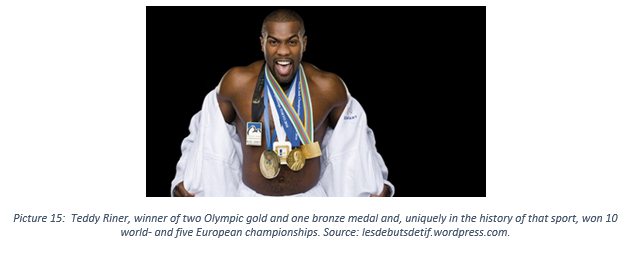
All in all, it is clear that racial, gender, religious etc. forms of discrimination are all present in sport. But the major international sports events have also become forums of struggle against racism, anti-semitism and xenophoby, and for the peaceful co-existence of religions, as show in these picture. The new developments are largely the results of great media publicity.
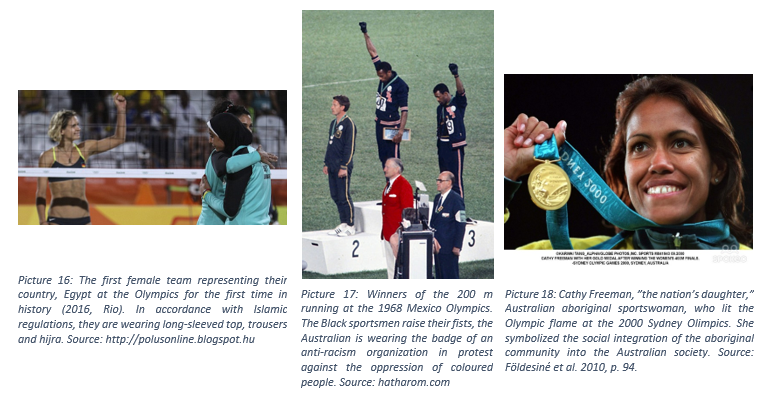
Control questions
What factors, and in what ways, have influenced young people’s habits of doing sports since 2000?
How do the various forms of racial, gender and ethnic discrimination appear in sports?
What does Kournikova-syndrome mean?
The expression comes from the–now retired–tennis star, Anna Kournikova, who never won a Grand Slam tournament, but still dominated sports media. The extraordinarily attractive sportswoman appeared in the press more often than her competitors even when she was injured and unable to enter a tournament (Gál et al. 2008).↩︎